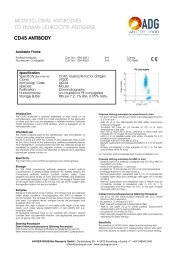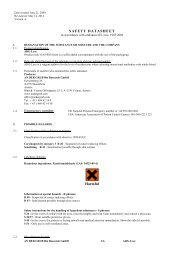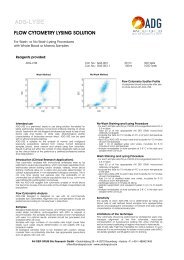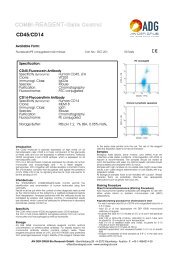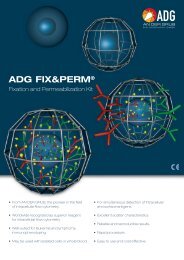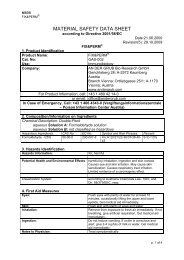Pdf-download - AN DER GRUB Bio Research Gmbh
Pdf-download - AN DER GRUB Bio Research Gmbh
Pdf-download - AN DER GRUB Bio Research Gmbh
You also want an ePaper? Increase the reach of your titles
YUMPU automatically turns print PDFs into web optimized ePapers that Google loves.
FIX&PERM ®<br />
CELL PERMEABILIZATION KIT<br />
For suspension stainings and flow cytometric<br />
analyses of intracellular antigens.<br />
Reagents provided:<br />
Reagent A (Fixation Medium) Cat. No.: GAS-002A-1 100 ml 1000 Tests<br />
Reagent B (Permeabilization Medium) Cat. No.: GAS-002B-1 100 ml 1000 Tests<br />
Lactoferrin-PE<br />
Lactoferrin-PE<br />
Normal BM: Leukogate<br />
MPO - FITC<br />
Leukemic BM: Blastgate<br />
MPO - FITC<br />
Intended use<br />
This FIX&PERM ® Cell Permeabilization Kit contains 2 reagents: Fixation<br />
Medium (Reagent A) and Permeabilization Medium (Reagent B). It is<br />
intended for first fixing cells in suspension with Reagent A and then<br />
permeabilizing the cell membranes with Reagent B. This procedure gives<br />
antibodies access to intracellular structures and leaves the morphological<br />
scatter characteristics of cells intact. Specific formulations reduce<br />
background staining and allow simultaneous addition of permeabilization<br />
medium and fluorochrome labeled antibodies.<br />
FIX&PERM ® is suitable for the analysis of normal and malignant leukocyte<br />
populations derived from various human biological samples (blood, bone<br />
marrow and others) using flow cytometry. Results must be put within the<br />
context of other diagnostic tests as well as the clinical history of the patient<br />
by a certified professional before final interpretation.<br />
Introduction<br />
Flow cytometric analyses with monoclonal antibodies were so far mainly<br />
restricted to cell surface molecules. Intracellular structures such as<br />
cytoplasmic or nuclear enzymes, oncoproteins, cytokines, immunoglobulins<br />
etc. were largely excluded from such studies. Also excluded from flow<br />
cytometric studies were cytoplasmic localizations of well established<br />
membrane molecules like CD3 and CD22, which, in their cytoplasmic form,<br />
are the most reliable lineage markers in undifferentiated leukemia. With<br />
the FIX&PERM ® Kit flow cytometric analysis of intracellular antigens has<br />
become as easy as surface antigen studies. The only prerequisite is the<br />
availability of suitable antibody conjugates. Most of the available<br />
monoclonal antibody conjugates can be used with the FIX&PERM ® Kit,<br />
some determinants are sensitive, however, to the fixation step involved.<br />
This and the optimal fixation time have to be tested for each reagent. Some<br />
staining examples with ADG antibody conjugates are shown above.<br />
CD22 - PE<br />
CD3 - PE<br />
VIM2 FITC<br />
MPO - FITC<br />
Cytoplasmic staining with ADG CD22-PE<br />
conjugate of undifferentiated leukemia cells<br />
of B-ALL type<br />
Cytoplasmic staining with ADG CD3-PE<br />
conjugate of surface CD3 negative undifferentiated<br />
leukemia cells of T-ALL type<br />
Cytoplasmic staining with ADG anti MPO-<br />
FITC conjugate of un-differentiated<br />
leukemia cells of AML type<br />
Flow Cytometric Analysis<br />
FIX&PERM ® Reagents are designed for use with all commercially<br />
available flow cytometers. Alignment and compensation should be<br />
performed according to manufacturer´s instructions.<br />
Samples<br />
<strong>Bio</strong>logical fluids (blood, bone marrow, and others) must be collected<br />
under sterile conditions. Anticoagulation with EDTA or heparin is<br />
recommended. The samples should be stored at room temperature until<br />
used. For optimal results, samples should be processed and analyzed<br />
within 24 hours. Samples with high numbers of non-viable cells might<br />
cause false results, such cases require determination of cell viability<br />
with e.g. propidium iodide. All biological samples have to be handled<br />
with caution. Always consider them as potentially infective. Use<br />
appropriate precautions such as gloves, lab-coat, etc.<br />
Permeabilization and Staining Procedure<br />
- For each sample to be analyzed add 50 µl of whole blood, bone<br />
marrow or mononuclear cell suspension in a 5ml tube<br />
- Add 100 µl of Reagent A (Fixation Medium, stored and used at room<br />
temperature)<br />
- Incubate for 15 minutes at room temperature<br />
- Add 5ml phosphate buffered saline and centrifuge cells for 5 minutes<br />
at 300 g<br />
- Remove supernatant and add to cell pellet 100 µl Reagent B<br />
(Permeabilization Medium) and 20 µl of the appropriate ADG<br />
monoclonal antibody conjugate<br />
- Vortex at low speed for 1-2 seconds<br />
- Incubate for 15 minutes at room temperature<br />
- Wash cells with phosphate buffered saline as described above<br />
<strong>AN</strong> <strong>DER</strong> <strong>GRUB</strong> <strong>Bio</strong> <strong>Research</strong> GmbH • Gerichtsberg 28 • A-2572 Kaumberg • Austria • F: +43/1/489421450<br />
office@andergrub.com • www.andergrub.com
- Remove supernatant and resuspend cells in sheath fluid for immediate<br />
analysis or resuspend cells in 0.5 ml 1.0 % formaldehyde and store them<br />
at 2-8°C in the dark. Analyze fixed cells within 24 hours.<br />
Comments: Special cases (diluted bone marrow samples, other samples<br />
containing low soluble protein) might benefit from replenishment with<br />
plasma components before the FIX&PERM ® treatment in order to create<br />
a milieu, which more closely resembles the stuation in anti-coagulated<br />
blood. For that pupose addition of IgG preparations (e.g. Beriglobulin P,<br />
ZLB Behring, final concentration 10mg/ml) and human serum albumin<br />
(e.g. human albumin “Behring” 20% - infusion solution, final<br />
concentration 40mg/ml) is recommended.<br />
Sensitivity<br />
The quality of each FIX&PERM ® Lot is determined by fixation and<br />
permeabilization of well defined blood samples from representative donors<br />
and subsequent comparison of forward and side scatter characteristics of<br />
obtained leukocytes.<br />
Limitations of the technique<br />
Flow cytometry should be performed by professional users only. Improper<br />
alignment of the flow cytometer, inaccurate compensation of fluorescence<br />
leaking into other channels as well as incorrect positioning of regions may<br />
lead to false results.<br />
Lysis of red cells might be impossible for various reasons. In such instances<br />
it is recommended to isolate mononuclear cells (MNC) via density gradient<br />
centrifugation prior to staining.<br />
Results will be correct and reproducible as long as the procedures used<br />
respect the technical recommendations and obey good laboratory practice.<br />
The FIX&PERM ® solutions are provided in a concentration that will allow<br />
to fix and permeabilize human hematopoietic cells. It is therefore strongly<br />
recommended to stick to the working protocol in terms of concentration and<br />
volume regarding cells and antibody.<br />
The properties of FIX&PERM ® have been determined using EDTA anticoagulated<br />
peripheral blood.<br />
Precautions<br />
For professional users only.<br />
Reagent A of FIX&PERM ® Cell Permeabilization Kit contains fomaldehyde<br />
and is labelled: Harmful. Formaldehyde is toxic, allergenic and a suspected<br />
carcinogen. Never pipette by mouth and avoid contact with eyes, skin and<br />
clothing. Proper handling procedures are recommended.<br />
As a main rule, persons under 18 years of age are not allowed to work with<br />
this product. Users must be carefully instructed in the proper working<br />
procedure, the dangerous properties of the product and the necessary<br />
safety instructions. Please refer to the Material Safety Data Sheet (MSDS)<br />
for additional information.<br />
Storage<br />
FIX&PERM ® Cell Permeabilization Kit reagents should be stored and used<br />
at room temperature. Do not freeze. Stability of the reagent: Please refer to<br />
the expiry date printed onto the vial. The use of the reagent after the<br />
expiration date is not recommended. If reagents are stored under any<br />
conditions other than those specified, the conditions must be verified by the<br />
user. Do not use reagents if a precipitate should form or discoloration<br />
occurs.<br />
If unexpected results are obtained which cannot be attributed to<br />
differences in laboratory procedures, please contact us.<br />
Warranty<br />
The products sold hereunder are warranted only to conform to the<br />
quantity and contents stated on the label at the time of delivery to the<br />
customer. There are no warranties, expressed or implied, that extend<br />
beyond the description on the label of the product. ADG`s sole liability<br />
is limited to either replacement of the products or refund of the<br />
purchase price. ADG is not liable for property damage, personal injury,<br />
or economic loss caused by the product.<br />
Selected References<br />
Gerna, G., Percivalle, E., Lilleri, D., Lozza, L., Fornara, C., Hahn, G., Baldanti, F. &<br />
Revello, M. G. (2005) J Gen Virol 86, 275-84.<br />
Groeneveld, K., te Marvelde, J. G., van den Beemd, M. W., Hooijkaas, H. &<br />
van Dongen, J. J. (1996) Leukemia 10, 1383-9.<br />
Haranaga, S., Yamaguchi, H., Friedman, H., Izumi, S., & Yamamoto, Y. (2001) Infect<br />
Immun 69, 7753-9<br />
Hegazy, A. N. & Klein, C. (2008) Leukemia 22, 2070-9<br />
Kappelmayer, J., Gratama, J. W., Karaszi, E., Menendez, P., Ciudad, J., Rivas,<br />
R. & Orfao, A. (2000) J Immunol Methods 242, 53-65.<br />
Kline, M. P., Rajkumar, S. V., Timm, M. M., Kimlinger, T. K., Haug, J. L., Lust, J. A.,<br />
Greipp, P. R. & Kumar, S. (2007) Leukemia 21, 1549-60<br />
Knapp, W., Majdic, O. & Strobl, H. (1993) Recent Results Cancer Res 131,<br />
31-40.<br />
Knapp, W., Strobl, H. & Majdic, O. (1994) Cytometry 18, 187-98.<br />
Knapp, W., Strobl, H., Scheinecker, C., Bello-Fernandez, C. & Majdic, O.<br />
(1995) Ann Hematol 70, 281-96.<br />
Konikova, E., Glasova, M., Kusenda, J. & Babusikova, O. (1998) Neoplasma<br />
45, 282-91.<br />
Lanza, F., Latorraca, A., Moretti, S., Castagnari, B., Ferrari, L. & Castoldi, G.<br />
(1997) Cytometry 30, 134-44.<br />
Millard, I., Degrave, E., Philippe, M. & Gala, J. L. (1998) Clin Chem 44,<br />
2320-30.<br />
Nakase, K., Sartor, M. & Bradstock (1998) Cytometry 34, 198-202.<br />
Pascale, F., Contreras, V., Bonneau, M., Courbet, A., Chilmonczyk, S., Bevilacqua,<br />
C., Epardaud, M., Niborski, V., Riffault, S., Balazuc, A. M., Foulon, E., Guzylack-<br />
Piriou, L., Riteau, B., Hope, J., Bertho, N., Charley, B. & Schwartz-Cornil, I. (2008) J<br />
Immunol 180, 5963-72<br />
Pickl, W. F., Majdic, O., Kohl, P., Stockl, J., Riedl, E., Scheinecker, C.,<br />
Bello-Fernandez, C. & Knapp, W. (1996) J Immunol 157, 3850-9.<br />
Riera-Sans, L., & Behrens, A. (2007) J Immunol 178, 5690-700<br />
Roberts, J. L., Lengi, A., Brown, S. M., Chen, M., Zhou, Y. J., O'Shea, J. J. &<br />
Buckley, R. H. (2004) Blood 103, 2009-18<br />
Sargent, R. L., Craig, F. E. & Swerdlow, S. H. (2009) Int J Clin Exp Pathol 2, 574-82<br />
Scheinecker, C., Strobl, H., Fritsch, G., Csmarits, B., Krieger, O., Majdic, O. &<br />
Knapp, W. (1995) Blood 86, 4115-23.<br />
Sedlmayr, P., Grosshaupt, B. & Muntean, W. (1996) Cytometry 23, 284-9.<br />
Strobl, H. & Knapp, W. (2004) J <strong>Bio</strong>l Regul Homeost Agents 18, 335-9.<br />
Strobl, H., Scheinecker, C., Csmarits, B., Majdic, O. & Knapp, W. (1995) Br J<br />
Haematol 90, 774-82.<br />
Strobl, H., Scheinecker, C., Riedl, E., Csmarits, B., Bello-Fernandez, C., Pickl,<br />
W. F., Majdic, O. & Knapp, W. (1998) J Immunol 161, 740-8.<br />
Strobl, H., Takimoto, M., Majdic, O., Fritsch, G., Scheinecker, C., Hocker, P.<br />
& Knapp, W. (1993) Blood 82, 2069-78.<br />
Wang, X., Chang, X., Facchinetti, V., Zhuang, Y. & Su, B. (2009) J Immunol 182,<br />
3597-608<br />
IVD For professional use only.<br />
Explanation of symbols/ Erläuterung der Symbole<br />
REF Catalog number/ Bestellnummer<br />
IVD In vitro diagnostic medical device/ In-Vitro-Diagnostikum<br />
� Consult instructions for use/ Gebrauchsanweisung beachten<br />
18˚-24˚ Temperature limitation/ Zulässiger Temperaturbereich<br />
Harmful/ Gesundheitsschädlich<br />
LOT Batch code/ Chargenbezeichnung<br />
� Use by/ Verwendbar bis<br />
Contains sufficient for (N) Tests/ Enthält (N) Tests<br />
� Manufacturer/ Hersteller<br />
<strong>AN</strong> <strong>DER</strong> <strong>GRUB</strong> <strong>Bio</strong> <strong>Research</strong> GmbH • Gerichtsberg 28 • A-2572 Kaumberg • Austria • F: +43/1/489421450<br />
office@andergrub.com • www.andergrub.com



